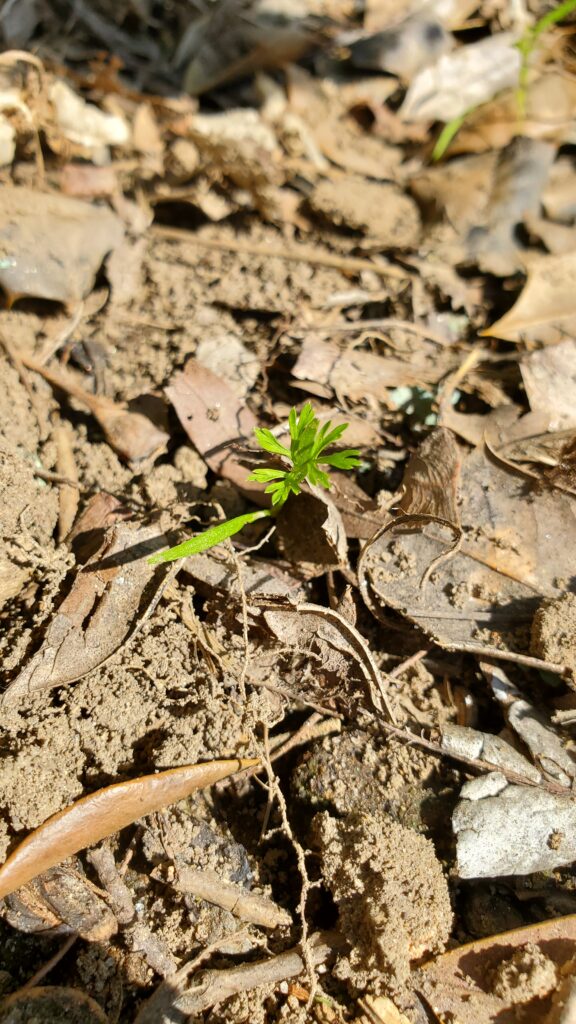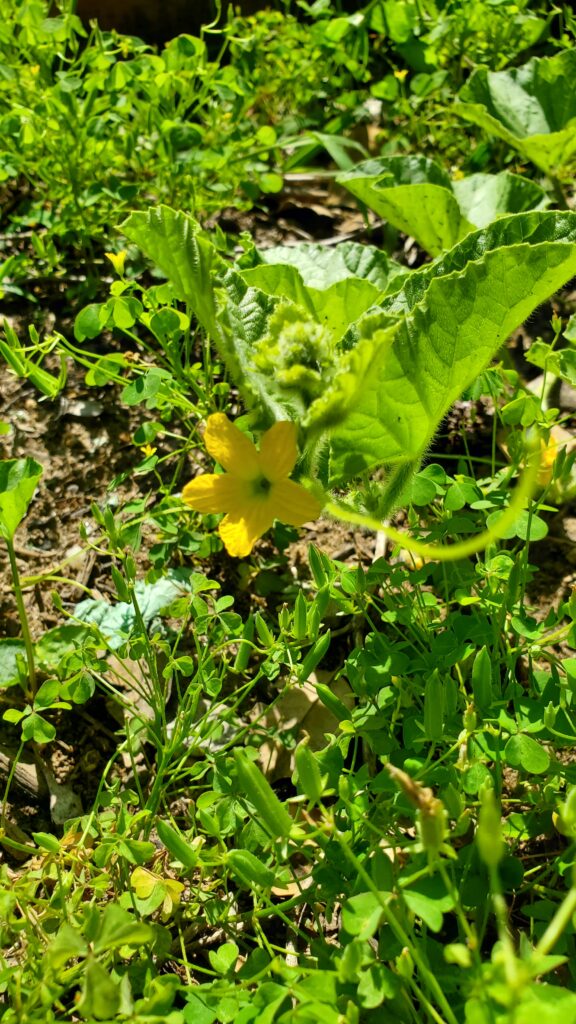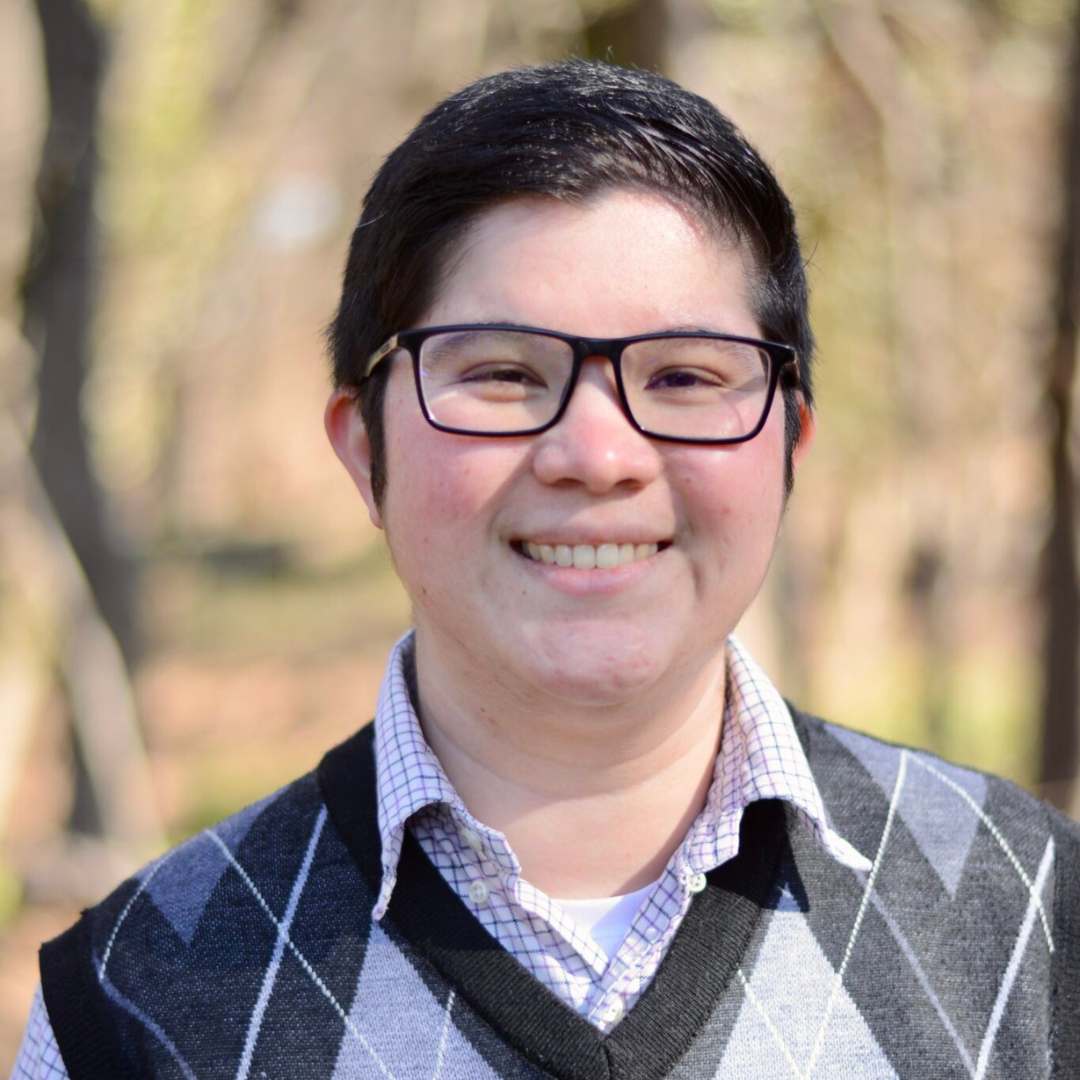I sit in my backyard on a cool and beautiful August day. Cicadas and crickets buzz. I’m away from my desk on a workday, but if my laptop’s on, even hours I spend lounging outside can be productive.
I’m working, of course. I have multiple programs open, and I’m typing away.
What I’m not sure I’m doing is “producing.”
Our scraggly food garden lies to my left. Mostly what’s growing there are weeds—clover, yellow wood sorrel and purslane—but not everything. The plot also hosts two melon vines that sprouted from my compost pile. They have flowers now; there’s a chance I’ll see cantaloupes this year. I see a handful of tiny carrot seedlings growing, too. We let their overwintered parent go to seed.


Farmers and gardeners call plants like these — ones that grow without human effort — volunteers. I’d call the weeds volunteers, too. My wife and I didn’t do anything to help them germinate and take root. Nevertheless, they shield the ground with their tender bodies and bring up water and minerals to share with fellow plants, the soil biota and us hungry, thirsty animals.
I catch myself thinking that humans don’t make anything the way plants do. We don’t draw carbon from the spinning mass of star-rock beneath us; we don’t absorb solar energy to fuse that carbon with nitrogen, hydrogen and oxygen, and create the life-making compounds that make us. We don’t fruit. We don’t produce.
Even those of us who garden and farm don’t create those crops. The plants do. At best, we move stuff around. Seeds. Water. Nutrients. Light and shade. It’s an uncommonly cynical thought for me.
Then I realize that’s all the plants are doing, too. They move nutrients through their cells and change their forms. Those new forms will be moved and changed again by other creatures and forces. Moving is what everything, animate or not, has done since creation. We’ve shuffled the stuff of the universe — matter and energy and so-called dark materials — from one place, one form, one combination, to another. Human beings, microbes, crickets, cantaloupes and even mineral atoms all have this power to move. To create things others need.
It’s not “productive” to think we don’t.
Throughout the Days of Awe, and particularly on Yom Kippur — the Day of Judgment — the movement of the moment is teshuvah, or repentance. Both words come from roots that mean “to turn.” Jews learn that Yom Kippur will atone for transgressions between us and the Divine, but earthly missteps require appeasing those we’ve wronged. We must make amends to repair damaged ties. When we do teshuvah, we return — re-turn — to a mutually respectful, ideally fruitful relationship of equals.
What kind of relationship should we return to with the earth?
Adam, the human being, famously comes from adamah, meaning earth. Read another way, though, adamah could mean “towards the human being” — adam-ah. The earth is already turned towards us, providing all we need to grow and thrive together. In return, we humans can volunteer to be more conscious and more conscientious about what we move, where we move it and how much of it we borrow to restore our productive partnership in creation.
Yom Kippur can teach us how.
On Yom Kippur, many of us refrain from working, putting aside for 25 hours the productivity we have been trained to prize. What do we do instead? We engage in tefillah, in prayer, and reflect on our deeds in the past year and previous seasons of our lives. Our tradition allots us time to digest what we have made, done and been, and gives us spiritual processes with which to learn from them and grow. In the year to come, we say we will do better.
The earth does the same. The year’s leaves and uneaten fruit fall and the composters of the world — worms and microbes and fungi — turn this litter into a nurturing medium for new life to come.



On Yom Kippur, some Jews fast from food and drink if it is safe for them to do so. Others abstain from other necessities and creature comforts. Jewish voices throughout the ages have proposed different rationales: showing penitence by action, engaging in mourning customs for our misses and misdeeds, practicing for death while we are sealed into the Book of Life and so on.
For me, the practice makes me intensely aware of what I normally eat, how often, where it might come from and how it came to me. What teshuvah do I need to make to be in right relationship with my food? Or with the world’s waters?
On Yom Kippur, Jews gather in numbers and pray in the we: Ashamnu. Avinu Malkeinu. We confess our guilt. We call on our Parent, our Sovereign. If we turn as a community towards our earth, what collective sins can we acknowledge and make right? If we look to one another, can we help ourselves find just ways to live interdependently within our people, with all peoples, with every species?
These are only a handful of the ideas that come to me as I set aside my laptop on a summer’s day. We can compost. We can eat thoughtfully. We can make it easier for everyone to reduce, reuse and recycle. There are so many ways we can volunteer the work of our hands to repair the earth and our coexistence with it, a literal tikkun olam. There is so much we can move in our homes and gardens, in our communities, in our cities, nations and legislation, in our relationships with all beings, and in our hearts, to facilitate the nourishment and growth of every part of Creation.
We can return, and re-turn, earthward.











